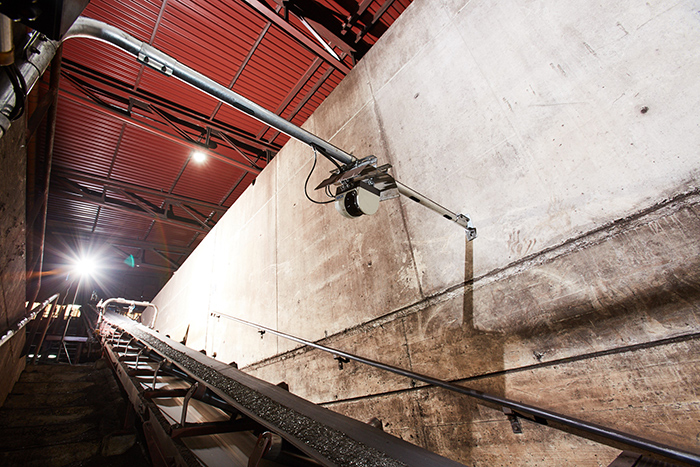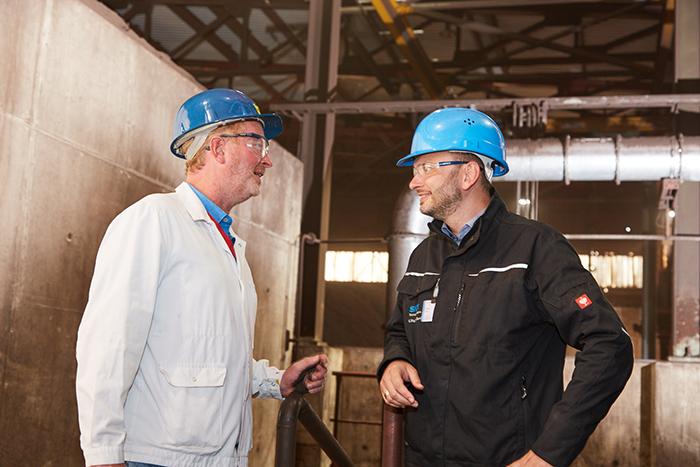Concrete is the most commonly used construction material in the world. Roof tiles, ceilings, stacks, facades, paving stones, staircases, cellars, garages, and trash cans are all made from it. The material is currently enjoying a change of image as regards its aesthetic appearance. Among other things, one reason for this is the trend away from drab gray to colored concrete materials. The Inorganic Pigments business unit from LANXESS today offers architects and concrete product manufacturers a range of over 100 color shades. By dyeing the concrete with synthetic iron oxide and chromium oxide pigments, it is therefore possible to provide the facades of luxury hotels or the paving stones of fashionable waterside promenades with an aesthetically attractive appearance, for example.
At its production site in Krefeld-Uerdingen, LANXESS uses five Bulkscan® LMS511 laser volume flowmeters from SICK for process optimization in material transportation of high-quality iron chips. Color pigments are obtained from this raw material in an oxidation process as well as a chemical precipitation process. For this purpose, the iron chips must be trans-ported to the individual processing stations. This is done using conveyor belts.
The iron mix makes the Color
The chips are ground, strained, and sorted or mixed for the planned color. This material is then stored before processing by oxidation into color pigments in powder form based on a 100-year-old recipe. These pigments are marketed under the name BAYFERROX®. The iron chips cover long distances on conveyor belts during their transformation.

Precise material management
As with any process, it is important to adapt the individual process and handling stages to each other during the plant planning stage. This is the only way to guarantee the optimum utilization of the plant. In the bulk materials conveyor process, this means that the plant downstream of the conveyor belt is able to accept and handle the amount of bulk material delivered. If the amount of bulk material exceeds the handling capacity of the subsequent stages, there will be overfilling and material blockage that will ultimately cause downtime of the plant. Furthermore, machines and conveyor belts may be damaged, further lengthening the downtime.

Achim Eumes, LANXESS Deutschland GmbH and Patrick Janz, SICK Vertriebs-GmbH
“On the one hand, we would like to know what quantity and what volume is currently being transported on the conveyor belt so that the plant is not overloaded,” explains Achim Eumes, Process Control Technology Inorganic Pigments, LANXESS Deutschland GmbH. “We have installations that are able to transport lower quantities than the upstream sections due to the plant design. Using the laser volume flowmeters, we measure and control the volume so that the plant does not become blocked. On the other hand, we can also control the metering flow in a sensible way over the course of the day and thus get a feeling for the capacity utilization of the plant.”
“We have a classic control loop at two locations. The Bulkscan supplies us with the current actual value for the quantity being transported on the conveyor belt. Setpoint values are addi-tionally used for control at certain points,” says Achim Eumes when describing process con-trol. “The measurement supplies the actual value and the controller then adapts the desired quantity by means of the speed of the first screw conveyor. This results in a constant transport flow.”
Better performance with 5-echo technology
“We were looking for a non-contact measuring principle,” says Achim Eumes to explain the starting situation. “However, it is a great challenge for an optical device to function in such an environment, i.e., detecting the dark iron chip mass on a dark conveyor belt under difficult lighting conditions,” he adds.
The ultra-fast sampling technology from SICK enables high-precision laser measurement in virtually all weather and ambient conditions. The 5-echo technology is perfectly suited for applications that require the reliable detection of dynamic objects in changing or unfavorable conditions. Even for applications with poor visibility, such as in tunnels or in mines. In addition to maintaining excellent visibility in unfavorable weather conditions, 5-echo technology also ensures maximum accuracy.
The System

The laser scanners are mounted at five locations above the conveyor belt in the Krefeld-Uerdingen factory and continuously measure the height profile of the iron scrap passing un-derneath by laser pulsing. The laser radiation is eye-safe and corresponds to laser class 1. The notable aspect of this design is the reliable detection of the height profile, even with ex-ternal interference factors such as dust or bulk material suspended in the air. This is possible due to new signal analysis technologies, which are able to filter out the correct height profile signal reliably from a large number of echoes. The software algorithm reliably determines the correct signal from the various reflected laser pulses and at the same time reliably suppresses any haze that might interfere with measurement. Fast scanning frequencies of up to 75 Hz and fast response times are used both to achieve maximum resolution for the height profile (and thus high measurement accuracy) as well to enable measurement of fast conveyor belts moving at speeds of up to 30 meters per second.
The “Bulkscan” system from SICK offers six individually assignable switching outputs for fur-ther signal processing, e.g., as a warning or impulse output or as continuous outputs for measured value transmission over TCP/IP (Ethernet). Processing and measured value prep-aration take place directly in the sensor, which therefore also has two inputs. No additional data acquisition system is required. This facilitates mounting and commissioning.


